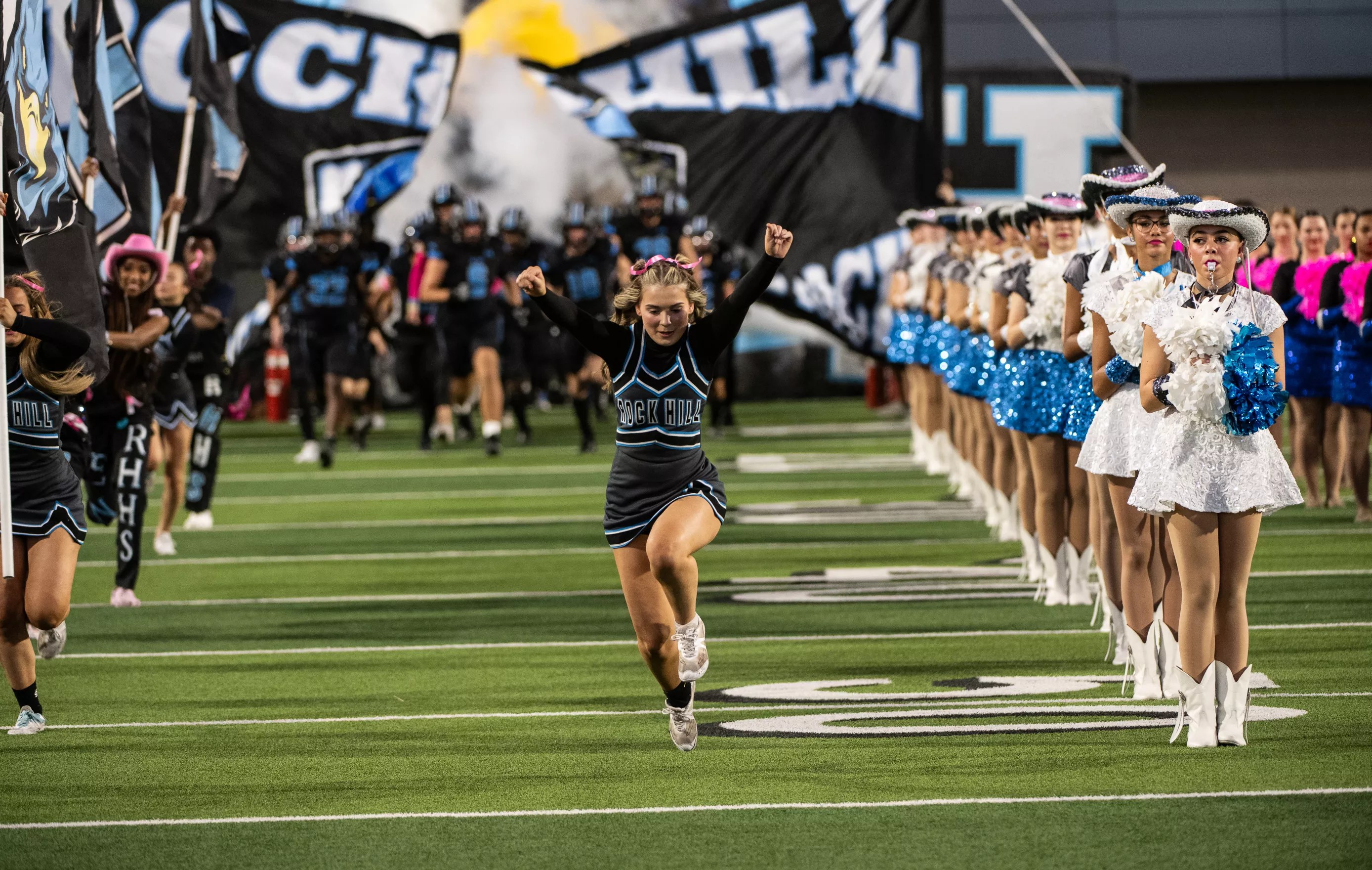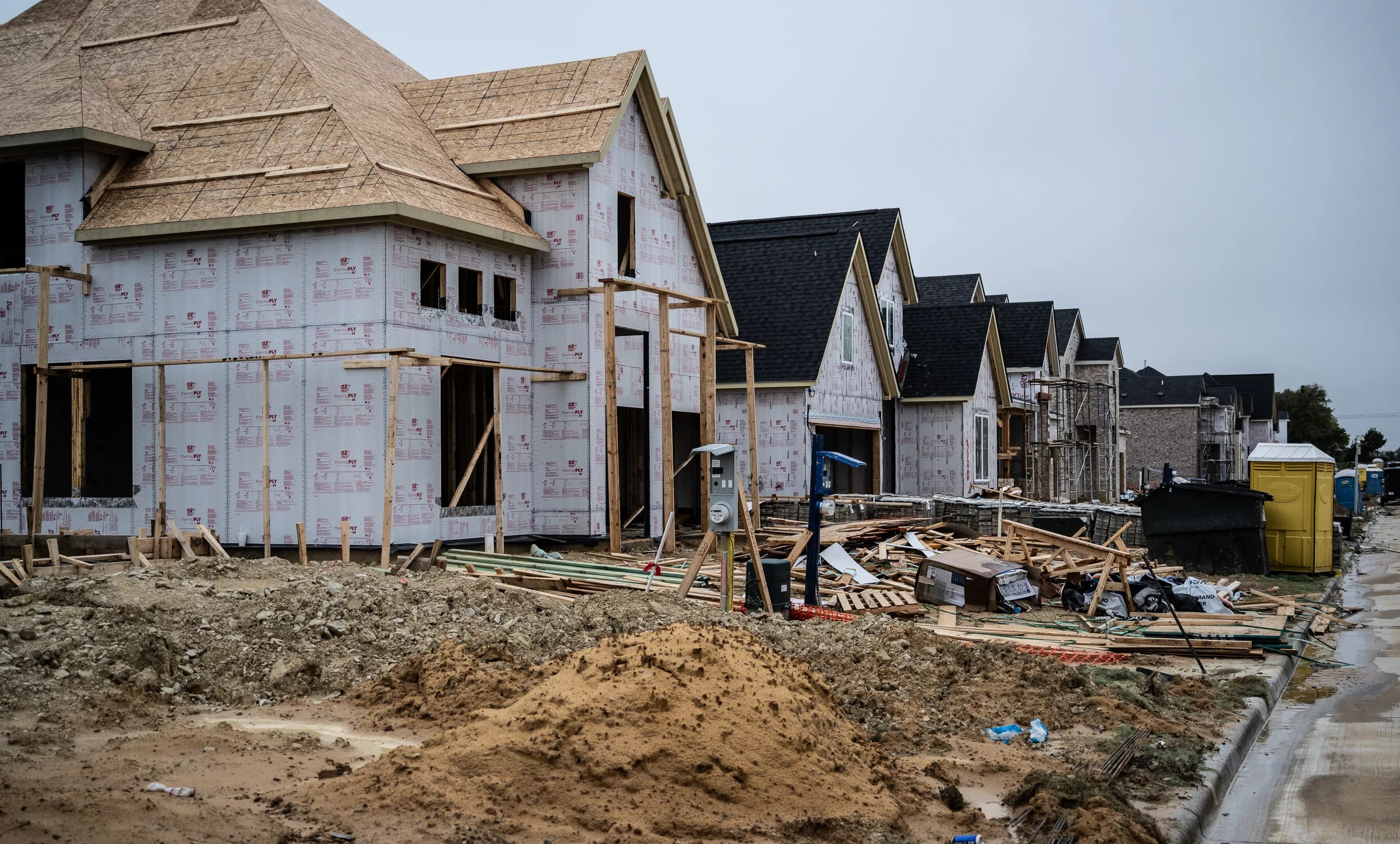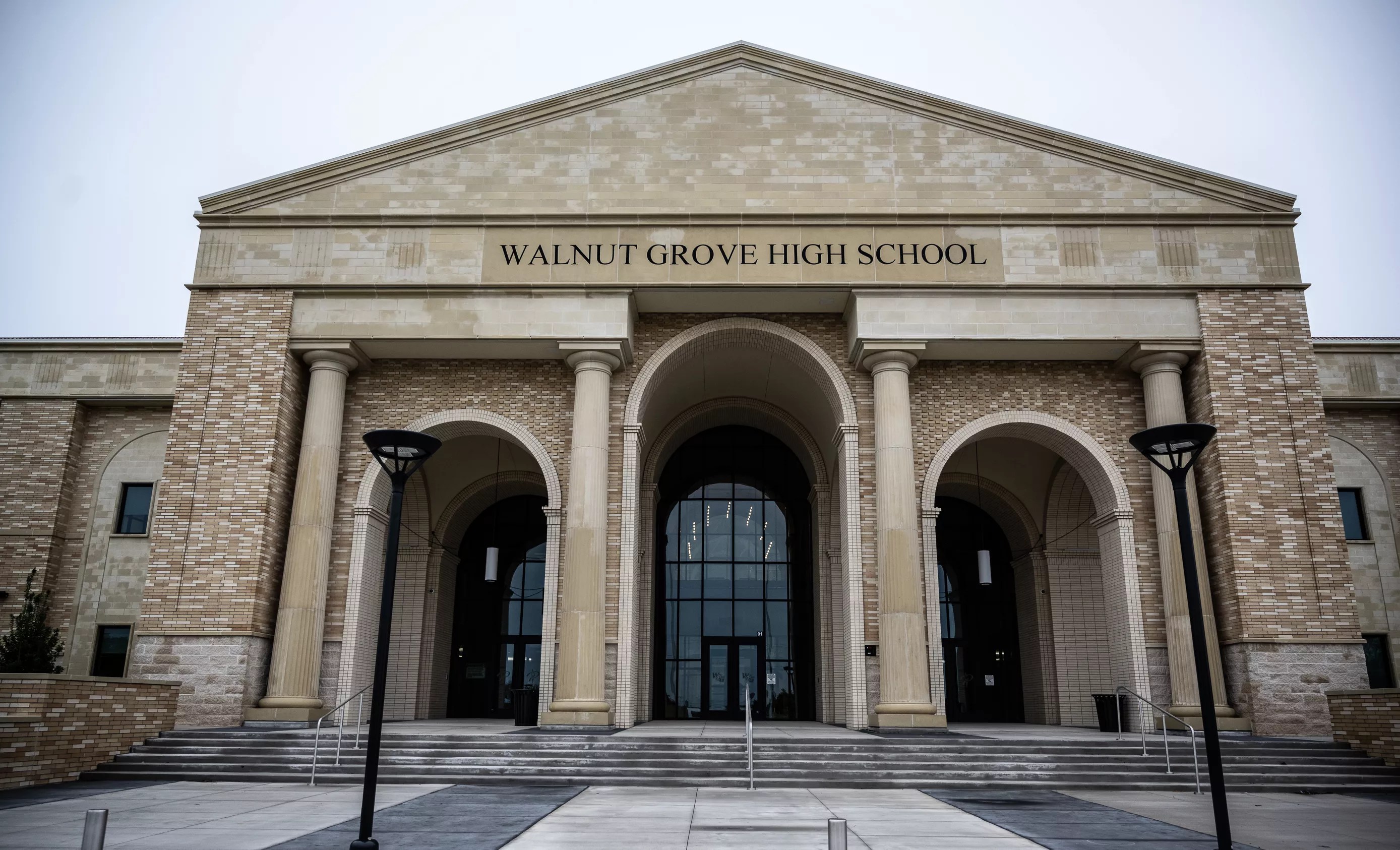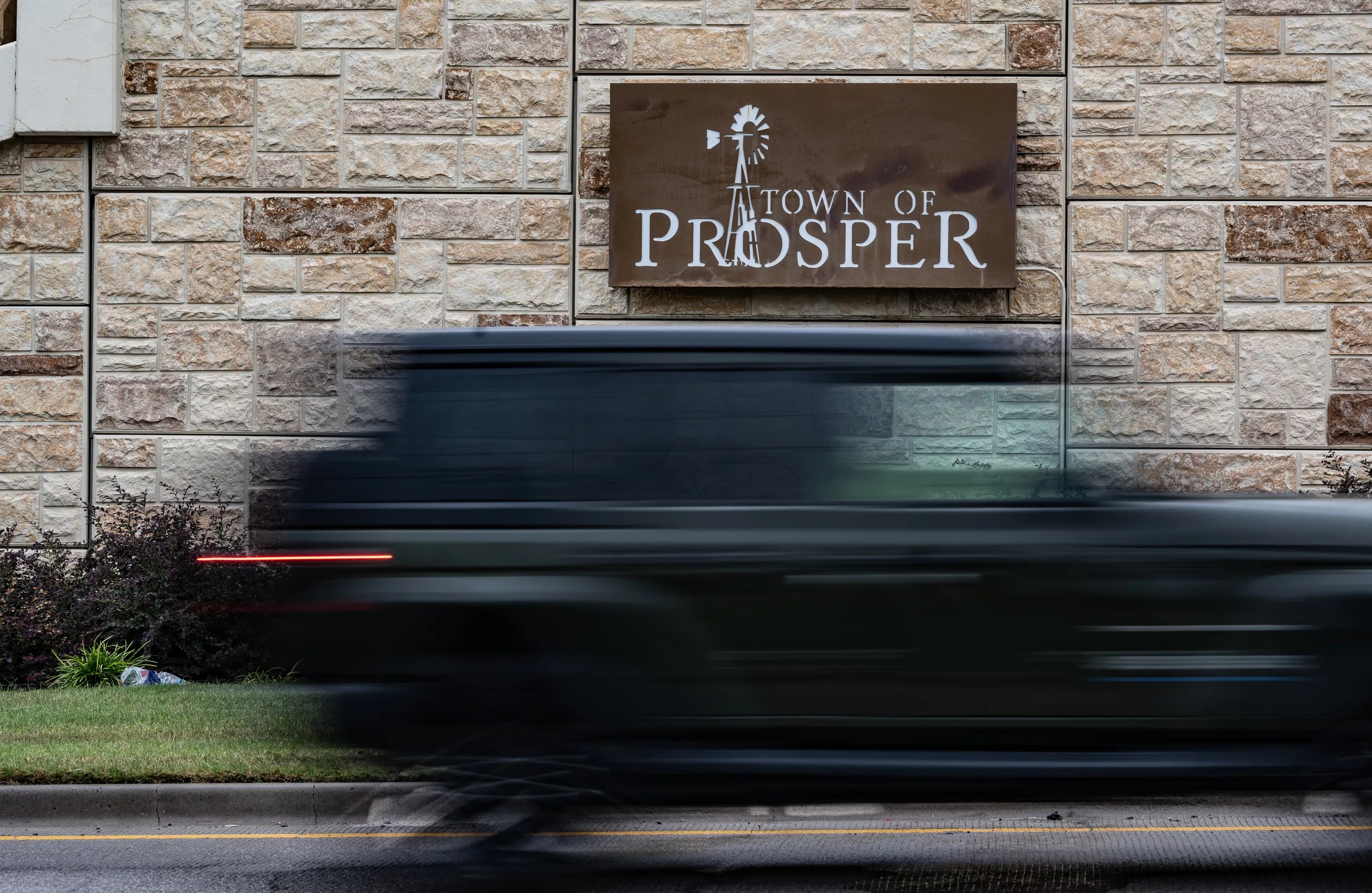
Mike Brooks

Audio By Carbonatix
Editor’s Note: 11/08/2023, 10:18 a.m.: According to reports, Prosper voters rejected Proposition C, which would allow for a new $94 million Prosper ISD football stadium, on Tuesday with 55% of voters choosing “no” for the proposition.
The grand cathedrals of arguably Texas’ favorite religion are as well-equipped as their high-tech counterparts in the clerical arena. Gone are the rusted bleachers, creaky stadiums and scoreboards with burned-out bulbs. They’ve given way to gigantic HD LED video screens that can light up a few city blocks, state-of-the-art press boxes with the latest in audio-visual broadcast technology, thousands upon thousands of seats with ample legroom and the most advanced, cushy turf money can buy. These are all vital parts of the gameday presentation and experience in the here and now.
This is football, and we’re in the Lone Star State, baby. The green and white gridiron is where our collective focus shifts when the ref blows that whistle. To be clear, we’re not talking about amenities at AT&T Stadium, where the Dallas Cowboys play, nor about NRG Stadium, the home of the NFL’s Houston Texans. No, we’re talking about North Texas high school football stadiums.
Not surprisingly, these thoroughly modern milieus come with enormous price tags.
Since more than 12 years ago, when Allen ISD made national headlines for its $60 million stadium, it seems as though there’s been a race by Texas school districts to outdo one another. In North Texas, at least one school district is trying to one up itself: by adding yet another new one to go along with its fairly new stadium – a far more expensive one.
Will you step up to support Dallas Observer this year?
At the Dallas Observer, we’re small and scrappy — and we make the most of every dollar from our supporters. Right now, we’re $14,500 away from reaching our December 31 goal of $30,000. If you’ve ever learned something new, stayed informed, or felt more connected because of the Dallas Observer, now’s the time to give back.
Is it a case of the Joneses trying to keep up with themselves, or is it just the cost of doing business for a school district experiencing astronomical growth? Probably a bit of both.
Early voting began last week for a $2.8-billion bond package in the Prosper ISD. It’s one of the largest school district bond packages in state history, and one of many high-dollar proposals that voters in Texas have had to consider in recent years. Also up for a vote this year, a $1.9-billion package for Conroe ISD. In 2022, Austin ISD offered a $2.4-billion bond package that was approved by voters.
Four propositions on the ballot cover a wide range of needs for Prosper ISD, including construction of new schools, improvements to existing facilities, providing new tech devices to both teachers and students and the building of a new performing arts center. But those aren’t attracting much attention outside of district that comprises parts of Collin and Denton counties.
Proposition C, which allows $94 million for the construction of a new football stadium, has made headlines across the state and beyond. Overall, the prop seeks $102,425, which would also provide artificial turf and new tracks at existing ISD athletic facilities.

New housing construction is underway in the Prosper community of Light Farms.
Mike Brooks
As one of the fastest-growing school districts in North Texas, Prosper ISD needs a great deal of cash to support upward of 3,000 new students per year. The district, which currently educates just over 28,000 students spread across 25 campuses, plans to add two new high schools over the next five years to its existing three. According to Prosper ISD chief communications officer Rachel Trotter, the district has come a very long way in a relatively short period of time, and new campuses and, yes, new stadiums, are necessary to support the influx of students.
The proposed $94-million stadium will be in addition to the district’s 12,000-seat Children’s Health Stadium, a nearly $50-million venue opened in 2019. If Prop C passes, the goal would be to have the new stadium open in 2028 when the district will have five high schools up and running.
“If you start trying to run five high schools though one stadium, you’re playing [football] on Thursday, Friday and twice on Saturday,” Trotter said. “I mean, you start running into scheduling issues, right?”
When Trotter lays out the projected growth for the district and what the past couple of decades have looked like for Prosper ISD, it’s not the craziest thing in the world to squint and see a need for an additional facility. Trotter pointed out that unlike other fast-growing ISDs such as nearby Frisco, McKinney and Allen, her district began its growth when it was not nearly as well-equipped as its neighbors, making the need for new construction more of a priority for Prosper, in her mind. Since 2001, Prosper ISD has increased by more than 20 campuses and more than 27,000 students.
“When the growth started in Prosper,” she said, “you’re talking about a very rural, agricultural community with less than a thousand kids in the school district. To me, that is the difference: Where we started and how fast we’ve gotten to where we are.”
Trotter pointed out that voters can vote for or against any of the four props, so that the money for a new stadium isn’t part of an all-or-nothing scenario. Another selling point is that the $94 million is representative of the maximum possible amount that will be approved for the stadium, not a definitive price tag. The proposed dollar amount takes into account inflation and what the planning and construction of a new stadium may cost in the coming years.
But not everyone is buying what the district is selling.

Children’s Health Stadium in Prosper.
Mike Brooks
Emily Cochrane, a mother of two school-aged children in Prosper ISD, has lived in the area since 2019. Her family moved into the district just after a $1.33 billion bond package was overwhelmingly approved by voters. Simply put: the numbers aren’t adding up to Cochrane, even if, she admits, they are doing so for many of her neighbors.
“When you compare our stadium to other stadiums in the state, such as Cypress-Fairbanks (Cy-Fair Federal Credit Union Stadium) or Katy ISD (Legacy Stadium), we are getting far less for the money,” Cochrane said. “With other districts in North Texas talking about closing schools and financial exigency, it is astounding to see so many people here apathetic about this huge number.”
Cochrane has been vocal in her opposition online, employing posts and memes on her personal Facebook page against Prop C. She aims to convey what she sees as the nuts and bolts, dollars and cents of the deal in an effort to counter the district’s talking points. Cochrane admits that she took her oldest child out of Prosper ISD after their kindergarten year.
“The entire bond campaign has been extremely misleading and stacked in favor of the bond,” Cochrane said. “I have received no less than eight marketing mailers about the bond with misleading facts on it – things like using growth from 2002. I should hope we have grown in 20 years, but that certainly presents a bigger number, and saying that it [the bond] doesn’t affect the tax rate. So, people are out here literally thinking this is ‘free money.'”
“Growth.” There’s that word again.
That Prosper ISD has experienced a remarkable increase in its student population in recent years is arguably the lone objective, inarguable fact in this debate. It’s not all just district families making more babies. A significant driver of the student surge is the high number of families that have moved in from outside the district, the state and even the country.
“We had 3,400 kids move in [to the district] last year,” Trotter noted. “Over half of those kids were from someplace other than Texas. Many of those families came from California. And then another group came from India. So, there’s something about this place that is bringing those families in, and I think if you talk to those folks, it’s the school district they’re coming in for. It’s not the view. This is not Malibu. We have some beautiful sunsets up here, but what else have you got to look at? Not a lot, right? They’re here for the quality of education.”
Cochrane called the eye-popping numbers of new students Trotter laid out as a “statistical anomaly from the pandemic,” which, she believes, is not sustainable.

Walnut Grove High School is opulent.
Mike Brooks
Iconic former Dallas Cowboys head coach Tom Landry once said that “football to Texas is like what religion is to a priest.” In Texas, football is king. It’s cliche, but it’s true. You don’t have to rely on generic examples such as the Friday Night Lights book, movie or TV series to understand the power that football has over Texans, Lone Star culture or our tax dollars. Hundreds of millions of publicly funded dollars were used to build both pro football stadiums in Arlington and Houston, for example.
Over the past decade or so, school districts in North Texas – specifically in Collin County – have set and broken records for the amount spent to build their stadiums. Even with the attention-grabbing examples nearby, Prosper ISD has managed to bring a bit of scrutiny upon itself for how comparatively lavish its new buildings are.
According to the 2021 census, the median household income in Prosper is $159,164, about double the national median, and the median value of owner-occupied homes was $524,700, which was well over double the national number.
Prosper may be a lesser-known North Texas exurb compared to Frisco, Allen or McKinney, but the town pulled plenty of eyeballs from around the world earlier this year that made the name “Prosper” seem rather on-the-nose. Upon its August opening, the $200 million Walnut Grove High School inspired incredulous headlines and breathless viral social media posts from all corners. To be sure, it’s a gorgeous campus. With a Sonic in the sprawling food court and gym facilities that rival many colleges, it’s the kind of school that the Beverly Hills 90210 crew would envy.
“With other districts in North Texas talking about closing schools and financial exigency, it is astounding to see so many people here apathetic about this huge number.” – Emily Cochrane, Prosper resident
That sort of new-money glamor doesn’t exactly help when it comes to the optics, at least to eyes outside of the district.
“Generally, we live in a very ostentatious town where people live in $2-$3 million homes, so they seem to think that [$94 million] is an acceptable going rate for a stadium,” Cochrane said. “They don’t understand that we can and should be pushing for more bids (not the highest guaranteed cost to Pogue [Construction]) and that the cost proposed is ridiculous, even with inflation.”
Gretchen Darby, a parent with three kids in the Prosper ISD, moved from Dallas a little more than four years ago for the school district, a more rural feel and what she believed would be a stronger sense of community. Darby volunteered for the district’s long-range planning committee, a group of more than 80 parents and community members who vetted bond opportunities.
She’s voting for all four props and thinks that people with opinions similar to Cochrane’s are off-base.
“No one that I know in Prosper ISD cares about whether Prosper ‘sets a new record’ for the most expensive stadium in Texas,” she wrote in an email. “That’s not important, and it’s not what this facility is all about. It’s just a buzz phrase that gained steam for the sake of argument. It stands to reason that every year – in the current economy and with the current price of construction, materials and labor – new stadiums built would cost more than the ones that came before them. It’s the state of new construction today, and those costs don’t appear to be decreasing in the near future. I would much rather Prosper ISD estimate high and not end up spending that much, than to estimate too low and have to go back to the drawing board.”
Even when you take away the disagreements over a district’s growth rate and the economy, the question remains: how appropriate is it to spend nearly $100 million on a high school stadium to begin with?
In Texas there’s a teacher shortage and a governor just itching to take money from public schools and funnel it into private ones. The most recent legislative session failed to yield many measures that would both attract and retain teachers, let alone provide for a teacher pay raise. This is in spite of the whopping, record-breaking surplus of more than $30 billion lawmakers were working with.
Furthermore, school tax rates will now be lower after Gov. Greg Abbott signed legislation for a number of property tax cuts earlier this year. That’s less money for school districts to collect, just to be clear. School bond money cannot be used for items such as teacher pay and benefits, only for major capital expenditures – like those included in Prosper’s four propositions.
Prosper ISD says the proposed new stadium will serve many purposes beyond football, including hosting band events and other sports such as soccer. Students will be able to learn audio-visual broadcasting and presentation skills during games, and the new stadium will also have a running track, something Children’s Health Stadium doesn’t have. Of course, these are all activities that are already taking place every week throughout the state in stadiums far less expensive than what Prop C offers.

Prosper is growing quickly, adding shopping areas, new schools and stadiums.
Mike Brooks
Speaking of property and school tax rates, the district has adamantly asserted that local property tax rates will not increase, thanks to the 2007 decision by Prosper ISD to set “the Interest and Sinking portion of the tax rate to 50 cents per $100 property valuation (as set by the county appraisal district), which is the maximum allowed by the State of Texas,” according to the district’s website.
Trotter said the decision of what is and is not appropriate in this case is completely up to the residents of the district. If they approve it, she suggests, they’re accepting the terms of the transaction. But school bonds in Texas don’t live only inside individual district vacuums.
The bond debt is guaranteed by the state’s permanent school fund, which currently sits above $50 billion; the state would be responsible for paying bondholders should the district default. The defaulted amount would be deducted from any future state aid payments to the district.
Trotter understands that headlines mentioning a $94-million high school stadium will get a lot of scrutiny, but she’s quick to point out that because the district is planning ahead, possibly as much as five years into the future, things may end up differently in terms of the final dollar amount and other considerations.
“If the growth stopped tomorrow, if all of a sudden the gates closed or the faucet turned off and nobody moved into Proper, that would change every bit of the plan,” she said.
In North Texas, new high school stadiums will continue to be built and, most likely, continue to be done so at alarmingly costly figures. Maybe districts like Prosper ISD are just taking the words of another Hall of Fame football coach to a high-dollar level that he certainly would never have imagined.
“A school without football,” said Vince Lombardi, “is in danger of deteriorating into a medieval study hall.”